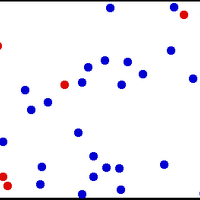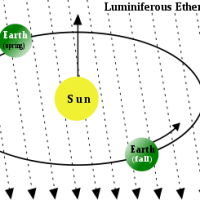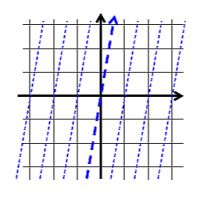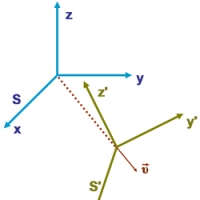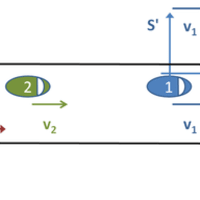すべてが相対的な座標であれば、
一体、すべての運動をどのように記述したらよいのか、
ニュートンは考えました。
相対的でない、オリジナルの運動形式を
正確に把握できる方法はあるだろうか?
(そうでなければ、見せかけの運動形式を、
それが真の運動形式だと思い込んでいるだけで、
正確な初期条件を得ることができず、
古典力学が目的とする正確な予測ができなくなるからです。)
地球上では、たくさんの座標系を持って、運動しています。
地球上だけでなく、太陽系のすべての惑星でも同じことです。
そして、すべてがお互いに対して(相対的に)動いています。
ニュートンは、いわば、無数の人間の視点で座標系がある現状で、
太陽系の星々は、皆、整然とした物理法則で運行していることから、
誰か、人間の視点を超えた第三者が、
すべての物理現象を総合的に見ている(管理している)
と考えました。
(なぜなら物理現象が、万物に及んでいるからです)
そして、この人間の視点を超えた第三者が、
あらゆる相対座標系、慣性系を独自の視点で見ていると考えたのです。
それが、『神の座標 絶対空間 絶対時間』という概念です。
「絶対時間」とは、
ほかの何ものにも影響されずに、
独立して継続的に、一様に流れて行く時間であり、
「絶対空間」とは、
ほかの何ものにも影響されずに、
「不動なるもの」を中心にして独立して存在している空間です。
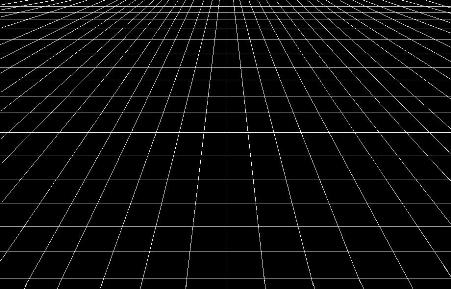
『絶対空間 絶対時間』の座標は、直交座標がもとになっており、
3次元で、格子状になっており、
すべての点(全宇宙)で同じ時を刻みます。
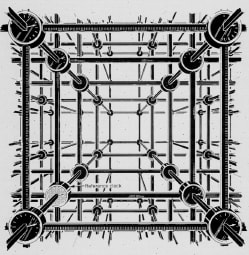
この座標の特徴は、
「ユークリッド幾何学を前提にしたもので、
形而上学的な定義を含み、
永遠から永遠へ、形と流れが変化しない固定した時空の座標である」
ということにあります。
形而上学的な定義という意味は、
厳密な意味では、人間の目には見えないものであり、
また触ったり、取り出したりすることはできないが、
無いわけではなく、むしろそれがなければ万物が形成されないもの、
ということになります。
例を挙げると、
私たちは学校で、「円」(丸い形)ということを習います。
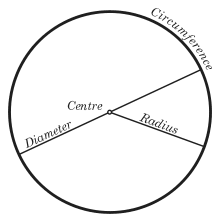
そして、角度の問題や接線の問題など、
幾何学の問題を解くことがありますが、
しかし実際には、幾何学で問題に出されている「真円」(正円)は、
現実の世界では、存在していません。
というのも、鉛筆やコンパスでどんなに丁寧に描いても、
太さが変わったり、ずれたりするからです。
また、正確な図を描くのにコンピューター(パソコン)で描いても、
ドット表示のため、拡大すると、ギザギザになっているか、
周囲がぼやけている表示なっている(がびがびな円である)わけです。

同じく、『絶対空間 絶対時間』も、
この現象世界には、取り出すことができないものです。
しかし、この概念がなければ、
「不動点(原点O)を中心とした真の運動形式」
が扱えなくなるのです。
※また、全宇宙で一様に、均等に流れる絶対時間がなければ、
時間が早く流れる場所と、遅く流れる場所とで、
同じ運動の時間も前後してしまうことになり、
重要な宇宙の法則、因果関係が壊れてしまいます。
そのため、ニュートンは、この考えを導入しました。
Philosophiae naturalis principia mathematica
『自然哲学の数学的諸原理』アイザック・ニュートン
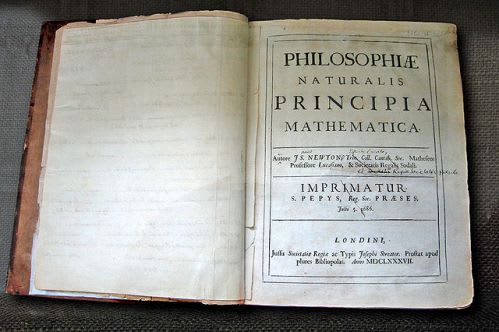
The Mathematical Principles of Natural Philosophy (1729)/Definitions
(訳 鈴木てつや)
Upon which account, the true and absolute motion of a body cannot be determin'd by the translation of it from those which only seem to rest. For the external bodies ought not only to appear at rest, but to be really at rest.
このような理由から、真の、そして絶対的な運動というものは、ただ一見すると止まっているかのように見える人が、観測するということだけで決定することはできません。なぜかというと、(観測する側の)外部の存在も、止まっているように見えるだけでなく、本当に(完全に)止まっていなくてはならないからです。
It is indeed a matter of great difficulty to discover, and effectually to distinguish, the True motion of particular bodies from the Apparent: because the parts of that immovable space in which those motions are perform'd, do by no means come under the observation of our senses. Yet the thing is not altogether desperate; for we have some arguments to guide us, partly from the apparent motions, which are the differences of the true motions; partly from the forces, which are the causes and effects of the true motions.
特定の、もろもろの物体の真の運動を、その見かけ上の運動から効果的に区別し、発見することは、実際には非常に難しいことです。なぜかといえば、運動が行われる中で、(重要な)不動の空間における座標というのは、私たち人間の観測する感覚世界には、決して入ってこない情報だからです。しかし、(見極めが)絶望的なわけではありません。というのも、(不動の空間における真の運動の)手がかりが、一つは、「真の運動と見かけ上の運動の差異」から見出すことができ、もうひとつは、因果関係を構成している「力」から見出すことができるからです。
Wherefore entire and absolute motions can be no otherwise determin'd than by immovable places; and for that reason I did before refer those absolute motions to immovable places, but relative ones to moveable places. Now no other places are immovable, but those that, from infinity to infinity, do all retain the same given positions one to another; and upon this account, must ever remain unmov'd; and do thereby constitute, what I call, immovable space.
そのようなわけで、完全なる、そして絶対的な運動(形式)というものは、「不動なる場所」から測定する以外には決定されないことになります。このような理由で、私は「絶対運動」を「不動なる場所」からのものとして言及し、「相対運動」を「互いに動いている場所」からのものとしたのです。そして、「不動なる場所」というものは、「無限から無限へと、すべてがお互いに固定した位置を与え続けられるもの」、という以外には在りえません。それは、いつまでも(互いに)位置を動かさない場所を構成し、保たれます。これを私は「不動なる空間」(=絶対空間)と呼びます。
『絶対空間 絶対時間』について
I. Absolute, true, and mathematical time, of itself, and from its own nature, flows equably without relation to anything external, and by another name is called duration: relative, apparent, and common time, is some sensible and external (whether accurate or unequable) measure of duration by the means of motion, which is commonly used instead of true time; such as an Hour, a Day, a Month, a Year.
I 絶対的な時間、真の時間、数学的な時間というものは、それ自身の天来の性質から、外部の何ものにも影響されずに、均等に流れて行くものであり、それゆえ、「持続(継続)」ともいいます。(絶対的な時間に対して)他方、相対的で、見かけ上の、そして(私たちにとって)日常的な「時間」というものは、ある種の「感覚的な時間」です。それらは、絶対的な時間の代わりに、一時間、一日、一月、一年などという形で、(精密なものも、不精密なものもありますが)外的な測度(※時計など)によって使われています。
II Absolute space, in its own nature, without relation to anything external, remains always similar and immovable. Relative space is some movable dimension or measure of the absolute spaces; which our senses determine by its position to bodies; and which is commonly taken for immovable space; such is the dimension of a subterraneous, an aerial, or celestial space, determined by its position in respect of the earth.
II 絶対的な空間というものは、その本性として、いかなる外部のものからの影響を受けずに、常に同じ性質を保ち、不動なるものです。(それに対して)相対的な空間というものは、(固定した絶対空間と違い)可動する次元(座標軸)を持っています。相対空間の中で、私たちは物体の場所を、(静止座標と見なした)ほかの物(位置)から測定しています。それは、(実際には測定できない)不動なる空間(真の運動)に対する代わりのものとして扱っています。そして、(絶対的空間に即するものとして)見えない不可思議なる、天界の物質である、「エーテル」というものが、地球を中心とした不動座標として考えられています。
IV. Absolute motion, is the translation of a body from one absolute place into another; and Relative motion, the translation from one relative place into another. Thus in a Ship under sail, the relative place of a body is that part of the Ship, which the Body possesses; or that part of its cavity which the body fills, and which therefore moves together with the Ship: And Relative rest, is the continuance of the Body in the same part of the Ship, or of its cavity. But Real, absolute rest, is the continuance of the Body in the same part of that Immovable space, in which the Ship itself, its cavity, and all that it contains, is moved. Wherefore, if the Earth is really at rest, the Body which relatively rests in the Ship, will really and absolutely move with the same velocity which the Ship has on the Earth. But if the Earth also moves, the true and absolute motion of the body will arise, partly from the true motion of the Earth, in immovable space; partly from the relative motion of the Ship on the Earth: and if the body moves also relatively in the Ship; its true motion will arise, partly from the true motion of the Earth, in immovable space, and partly from the relative motions as well of the Ship on the Earth, as of the Body in the Ship; and from these relative motions, will arise the relative motion of the Body on the Earth.
IV 絶対的な運動とは、ある物体が、ある絶対空間からある絶対空間へと移動することであり、相対的な運動とは、相対空間から相対空間へと移動することです。例えばもし、海上を帆走中の船があったとして、相対座標というのは、船全体のあらゆる場所であり、船の内部の空間も皆、含んでいます。そしてそれは船全体と一緒に動いているわけです。「相対的な静止」(船が海上で止まった)というのは、船の各部分と船内の空気も含めて、全体が止まっていることを意味します。しかし、本当の「絶対的な静止」という意味で考えると、船自体も、内部空間も、船の各部分も、(静止しておらず)動いているわけです。つまり、例えもし、地球が(絶対空間に対して)静止していたとして、船内にいる人が動かず、じっとしていたとして、(海にいるが)船が地球の動きと完全に同じであったとしても(潮の流れがなく海にくっつくように浮いているとしても)、地球が、本当は絶対空間に対して、真の運動として動いている場合や、船が地球に対して相対的に動いている場合や、船の中にいる人が、船の中で動いている場合は、これらの相対的な複合の運動が、地球に対しての相対運動の大きさを加算させることになるからです。
一体、すべての運動をどのように記述したらよいのか、
ニュートンは考えました。
相対的でない、オリジナルの運動形式を
正確に把握できる方法はあるだろうか?
(そうでなければ、見せかけの運動形式を、
それが真の運動形式だと思い込んでいるだけで、
正確な初期条件を得ることができず、
古典力学が目的とする正確な予測ができなくなるからです。)
地球上では、たくさんの座標系を持って、運動しています。
地球上だけでなく、太陽系のすべての惑星でも同じことです。
そして、すべてがお互いに対して(相対的に)動いています。
ニュートンは、いわば、無数の人間の視点で座標系がある現状で、
太陽系の星々は、皆、整然とした物理法則で運行していることから、
誰か、人間の視点を超えた第三者が、
すべての物理現象を総合的に見ている(管理している)
と考えました。
(なぜなら物理現象が、万物に及んでいるからです)
そして、この人間の視点を超えた第三者が、
あらゆる相対座標系、慣性系を独自の視点で見ていると考えたのです。
それが、『神の座標 絶対空間 絶対時間』という概念です。
「絶対時間」とは、
ほかの何ものにも影響されずに、
独立して継続的に、一様に流れて行く時間であり、
「絶対空間」とは、
ほかの何ものにも影響されずに、
「不動なるもの」を中心にして独立して存在している空間です。

『絶対空間 絶対時間』の座標は、直交座標がもとになっており、
3次元で、格子状になっており、
すべての点(全宇宙)で同じ時を刻みます。

この座標の特徴は、
「ユークリッド幾何学を前提にしたもので、
形而上学的な定義を含み、
永遠から永遠へ、形と流れが変化しない固定した時空の座標である」
ということにあります。
形而上学的な定義という意味は、
厳密な意味では、人間の目には見えないものであり、
また触ったり、取り出したりすることはできないが、
無いわけではなく、むしろそれがなければ万物が形成されないもの、
ということになります。
例を挙げると、
私たちは学校で、「円」(丸い形)ということを習います。

そして、角度の問題や接線の問題など、
幾何学の問題を解くことがありますが、
しかし実際には、幾何学で問題に出されている「真円」(正円)は、
現実の世界では、存在していません。
というのも、鉛筆やコンパスでどんなに丁寧に描いても、
太さが変わったり、ずれたりするからです。
また、正確な図を描くのにコンピューター(パソコン)で描いても、
ドット表示のため、拡大すると、ギザギザになっているか、
周囲がぼやけている表示なっている(がびがびな円である)わけです。

同じく、『絶対空間 絶対時間』も、
この現象世界には、取り出すことができないものです。
しかし、この概念がなければ、
「不動点(原点O)を中心とした真の運動形式」
が扱えなくなるのです。
※また、全宇宙で一様に、均等に流れる絶対時間がなければ、
時間が早く流れる場所と、遅く流れる場所とで、
同じ運動の時間も前後してしまうことになり、
重要な宇宙の法則、因果関係が壊れてしまいます。
そのため、ニュートンは、この考えを導入しました。
Philosophiae naturalis principia mathematica
『自然哲学の数学的諸原理』アイザック・ニュートン

The Mathematical Principles of Natural Philosophy (1729)/Definitions
(訳 鈴木てつや)
Upon which account, the true and absolute motion of a body cannot be determin'd by the translation of it from those which only seem to rest. For the external bodies ought not only to appear at rest, but to be really at rest.
このような理由から、真の、そして絶対的な運動というものは、ただ一見すると止まっているかのように見える人が、観測するということだけで決定することはできません。なぜかというと、(観測する側の)外部の存在も、止まっているように見えるだけでなく、本当に(完全に)止まっていなくてはならないからです。
It is indeed a matter of great difficulty to discover, and effectually to distinguish, the True motion of particular bodies from the Apparent: because the parts of that immovable space in which those motions are perform'd, do by no means come under the observation of our senses. Yet the thing is not altogether desperate; for we have some arguments to guide us, partly from the apparent motions, which are the differences of the true motions; partly from the forces, which are the causes and effects of the true motions.
特定の、もろもろの物体の真の運動を、その見かけ上の運動から効果的に区別し、発見することは、実際には非常に難しいことです。なぜかといえば、運動が行われる中で、(重要な)不動の空間における座標というのは、私たち人間の観測する感覚世界には、決して入ってこない情報だからです。しかし、(見極めが)絶望的なわけではありません。というのも、(不動の空間における真の運動の)手がかりが、一つは、「真の運動と見かけ上の運動の差異」から見出すことができ、もうひとつは、因果関係を構成している「力」から見出すことができるからです。
Wherefore entire and absolute motions can be no otherwise determin'd than by immovable places; and for that reason I did before refer those absolute motions to immovable places, but relative ones to moveable places. Now no other places are immovable, but those that, from infinity to infinity, do all retain the same given positions one to another; and upon this account, must ever remain unmov'd; and do thereby constitute, what I call, immovable space.
そのようなわけで、完全なる、そして絶対的な運動(形式)というものは、「不動なる場所」から測定する以外には決定されないことになります。このような理由で、私は「絶対運動」を「不動なる場所」からのものとして言及し、「相対運動」を「互いに動いている場所」からのものとしたのです。そして、「不動なる場所」というものは、「無限から無限へと、すべてがお互いに固定した位置を与え続けられるもの」、という以外には在りえません。それは、いつまでも(互いに)位置を動かさない場所を構成し、保たれます。これを私は「不動なる空間」(=絶対空間)と呼びます。
『絶対空間 絶対時間』について
I. Absolute, true, and mathematical time, of itself, and from its own nature, flows equably without relation to anything external, and by another name is called duration: relative, apparent, and common time, is some sensible and external (whether accurate or unequable) measure of duration by the means of motion, which is commonly used instead of true time; such as an Hour, a Day, a Month, a Year.
I 絶対的な時間、真の時間、数学的な時間というものは、それ自身の天来の性質から、外部の何ものにも影響されずに、均等に流れて行くものであり、それゆえ、「持続(継続)」ともいいます。(絶対的な時間に対して)他方、相対的で、見かけ上の、そして(私たちにとって)日常的な「時間」というものは、ある種の「感覚的な時間」です。それらは、絶対的な時間の代わりに、一時間、一日、一月、一年などという形で、(精密なものも、不精密なものもありますが)外的な測度(※時計など)によって使われています。
II Absolute space, in its own nature, without relation to anything external, remains always similar and immovable. Relative space is some movable dimension or measure of the absolute spaces; which our senses determine by its position to bodies; and which is commonly taken for immovable space; such is the dimension of a subterraneous, an aerial, or celestial space, determined by its position in respect of the earth.
II 絶対的な空間というものは、その本性として、いかなる外部のものからの影響を受けずに、常に同じ性質を保ち、不動なるものです。(それに対して)相対的な空間というものは、(固定した絶対空間と違い)可動する次元(座標軸)を持っています。相対空間の中で、私たちは物体の場所を、(静止座標と見なした)ほかの物(位置)から測定しています。それは、(実際には測定できない)不動なる空間(真の運動)に対する代わりのものとして扱っています。そして、(絶対的空間に即するものとして)見えない不可思議なる、天界の物質である、「エーテル」というものが、地球を中心とした不動座標として考えられています。
IV. Absolute motion, is the translation of a body from one absolute place into another; and Relative motion, the translation from one relative place into another. Thus in a Ship under sail, the relative place of a body is that part of the Ship, which the Body possesses; or that part of its cavity which the body fills, and which therefore moves together with the Ship: And Relative rest, is the continuance of the Body in the same part of the Ship, or of its cavity. But Real, absolute rest, is the continuance of the Body in the same part of that Immovable space, in which the Ship itself, its cavity, and all that it contains, is moved. Wherefore, if the Earth is really at rest, the Body which relatively rests in the Ship, will really and absolutely move with the same velocity which the Ship has on the Earth. But if the Earth also moves, the true and absolute motion of the body will arise, partly from the true motion of the Earth, in immovable space; partly from the relative motion of the Ship on the Earth: and if the body moves also relatively in the Ship; its true motion will arise, partly from the true motion of the Earth, in immovable space, and partly from the relative motions as well of the Ship on the Earth, as of the Body in the Ship; and from these relative motions, will arise the relative motion of the Body on the Earth.
IV 絶対的な運動とは、ある物体が、ある絶対空間からある絶対空間へと移動することであり、相対的な運動とは、相対空間から相対空間へと移動することです。例えばもし、海上を帆走中の船があったとして、相対座標というのは、船全体のあらゆる場所であり、船の内部の空間も皆、含んでいます。そしてそれは船全体と一緒に動いているわけです。「相対的な静止」(船が海上で止まった)というのは、船の各部分と船内の空気も含めて、全体が止まっていることを意味します。しかし、本当の「絶対的な静止」という意味で考えると、船自体も、内部空間も、船の各部分も、(静止しておらず)動いているわけです。つまり、例えもし、地球が(絶対空間に対して)静止していたとして、船内にいる人が動かず、じっとしていたとして、(海にいるが)船が地球の動きと完全に同じであったとしても(潮の流れがなく海にくっつくように浮いているとしても)、地球が、本当は絶対空間に対して、真の運動として動いている場合や、船が地球に対して相対的に動いている場合や、船の中にいる人が、船の中で動いている場合は、これらの相対的な複合の運動が、地球に対しての相対運動の大きさを加算させることになるからです。










